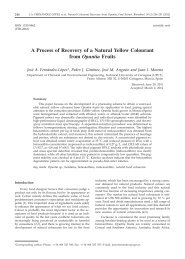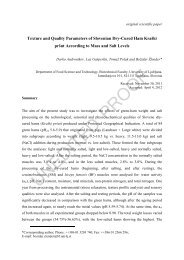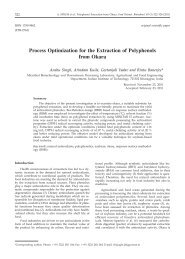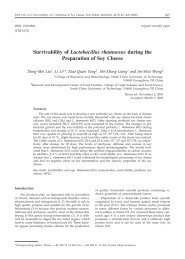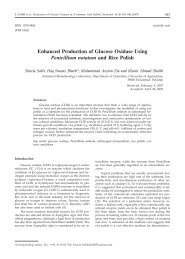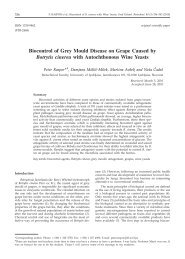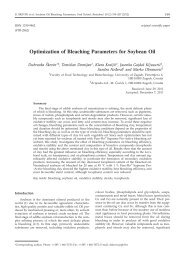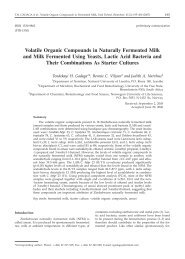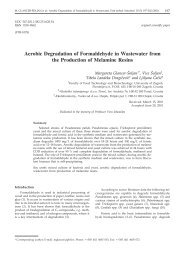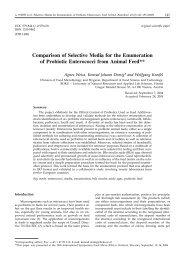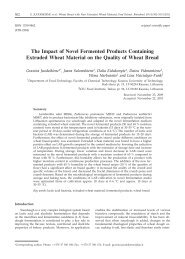Determination of Sorbitol Concentration in Diet Chocolate by High ...
Determination of Sorbitol Concentration in Diet Chocolate by High ...
Determination of Sorbitol Concentration in Diet Chocolate by High ...
Create successful ePaper yourself
Turn your PDF publications into a flip-book with our unique Google optimized e-Paper software.
S. PAPE[A et al.: <strong>Determ<strong>in</strong>ation</strong> <strong>of</strong> <strong>Sorbitol</strong> <strong>in</strong> <strong>Diet</strong> <strong>Chocolate</strong>, Food technol. biotechnol. 39 (2) 129–133 (2001)<br />
UDC 663.91:547.427.2:543.54 prelim<strong>in</strong>ary communication<br />
ISSN 1330-9862<br />
(FTB-1025)<br />
Introduction<br />
<strong>Determ<strong>in</strong>ation</strong> <strong>of</strong> <strong>Sorbitol</strong> <strong>Concentration</strong> <strong>in</strong> <strong>Diet</strong> <strong>Chocolate</strong><br />
<strong>by</strong> <strong>High</strong>-Performance Liquid Chromatography<br />
Sun~ica Pape{a 1* , Damir Je`ek 2 and Diana Kujund`i} 1<br />
1 »KRA[« Food Industry, Department <strong>of</strong> Health Regulation and Control<br />
2 Faculty <strong>of</strong> Food Technology and Biotechnology, University <strong>of</strong> Zagreb,<br />
Pierottijeva 6, HR-10000 Zagreb, Croatia<br />
Received: February 7, 2000<br />
Accepted: March 23, 2001<br />
Summary<br />
Confectionery products are among the ever <strong>in</strong>creas<strong>in</strong>g group <strong>of</strong> healthy foodstuffs. In<br />
the diet chocolate mass used <strong>in</strong> this study the sucrose was replaced with sorbitol and<br />
sweetener aspartame. A new method for determ<strong>in</strong>ation <strong>of</strong> sorbitol <strong>in</strong> diet chocolate <strong>by</strong><br />
high-performance liquid chromatography was developed, us<strong>in</strong>g the method <strong>of</strong> external<br />
standard on an ion–exchanger sugar column (Bio-Rad; Am<strong>in</strong>ex HPX 42C, 300 7.8 mm).<br />
The repeatability <strong>of</strong> the method was confirmed on the identical diet chocolate sample <strong>in</strong>jected<br />
six times. The statistical analysis <strong>of</strong> retention time <strong>of</strong> sorbitol peak, sorbitol peak<br />
area, sorbitol peak height and sorbitol concentration <strong>in</strong> the sample <strong>in</strong>cluded the follow<strong>in</strong>g<br />
parameters: mean value (x), standard deviation (S.D.), relative standard deviation<br />
(R.S.D.) and confidence <strong>in</strong>terval (C.I.). The results <strong>in</strong>dicate that this technique enables exact<br />
determ<strong>in</strong>ation <strong>of</strong> sorbitol content <strong>in</strong> diet chocolate, as well as other polyols <strong>in</strong> diet<br />
chocolates enabl<strong>in</strong>g new products development.<br />
Key words: diet chocolate, sorbitol, HPLC<br />
Sugar-free low-calorie products, enriched with healthy<br />
<strong>in</strong>gredients, are becom<strong>in</strong>g more popular, because<br />
consumers demand healthy products <strong>in</strong> confectionery<br />
<strong>in</strong>dustry as a part <strong>of</strong> their general dietary attitudes. <strong>Diet</strong><br />
foodstuffs are those that are <strong>in</strong>tended for <strong>in</strong>dividuals<br />
with metabolic disorders, i.e. diabetics. Such foodstuffs<br />
must satisfy certa<strong>in</strong> basic criteria: (i) fat fraction must<br />
not exceed the fat fraction <strong>in</strong> similar or related foodstuffs;<br />
(ii) glucose, glucose syrup, <strong>in</strong>vert-sugar or<br />
disaccharides must not be added dur<strong>in</strong>g production <strong>of</strong><br />
these foodstuffs. <strong>Diet</strong> milk chocolate is one <strong>of</strong> the<br />
low-calorie products and may be consumed <strong>by</strong> diabetics<br />
(1,2). In the cocoa products <strong>in</strong>dustry <strong>in</strong> Croatia the follow<strong>in</strong>g<br />
sugar substitutes may be used: sorbitol, xylitol,<br />
* Correspond<strong>in</strong>g author; Phone: ++385 (0)1 2396 531; Fax: ++385 (0)1 2396 070<br />
129<br />
mannitol, isomalt maltitol, maltitol syrup, lactitol and<br />
polydextrose (3).<br />
The aim <strong>of</strong> the experiments was to establish a new<br />
<strong>in</strong>expensive method for rout<strong>in</strong>e determ<strong>in</strong>ation <strong>of</strong> sorbitol<br />
<strong>by</strong> HPLC <strong>in</strong> chocholate mass, when sucrose was substituted<br />
<strong>by</strong> sorbitol. Furthermore, other methods <strong>of</strong><br />
sorbitol determ<strong>in</strong>ation were compared.<br />
There are several methods used for sorbitol determ<strong>in</strong>ation:<br />
(i) polarimetric method based on the fact that<br />
different sorbitol concentrations <strong>in</strong> water differ <strong>in</strong> the<br />
rotation <strong>of</strong> the plane <strong>of</strong> polarized light (4); (ii) enzymatic<br />
method based on the reaction <strong>of</strong> sorbitol-dehydrogenase<br />
that <strong>in</strong> the presence <strong>of</strong> NAD + oxidizes D-sorbitol <strong>in</strong>to<br />
fructose (5) and the obta<strong>in</strong>ed NADH is determ<strong>in</strong>ed
130<br />
spectrophotometrically; (iii) periodic acid method which<br />
enables determ<strong>in</strong>ation <strong>of</strong> sorbitol concentration on the<br />
basis <strong>of</strong> the used periodic acid (6); (iv) gas-chromatographic<br />
(GC) method, carried out on the capillary column<br />
us<strong>in</strong>g the <strong>in</strong>ternal standard; and (v) high performance<br />
liquid-chromatographic (HPLC) method, <strong>in</strong><br />
which external and <strong>in</strong>ternal standards are separately<br />
used (7).<br />
Materials and Methods<br />
Chemical<br />
For determ<strong>in</strong>ation <strong>of</strong> sorbitol the follow<strong>in</strong>g chemicals<br />
were used: redistilled water, Kra{; enzymatic test-<br />
-comb<strong>in</strong>ation for sorbitol/xylitol, Boehr<strong>in</strong>ger Ma<strong>in</strong>nheim;<br />
Sorbitex P, Krefeld, Germany; Carrez-I-solution (potassium<br />
hexacyan<strong>of</strong>errate K 4Fe(CN) 63 H 2O), Carrez-II-<br />
-solution (z<strong>in</strong>c sulfate, Zn SO 4 7H 2O), Kemika, Croatia;<br />
NaOH, p.a. Kemika, Croatia.<br />
<strong>Chocolate</strong> sample<br />
The ma<strong>in</strong> <strong>in</strong>gredientes <strong>of</strong> the diet chocolate are:<br />
milk powder, sugar substitute sorbitol, cocoa butter, cocoa<br />
mass, vegetable fat, hazelnuts, aspartame and vanil<strong>in</strong><br />
(8).<br />
Tehnological process <strong>of</strong> diet chocolate production<br />
<strong>in</strong>cludes: (i) mix<strong>in</strong>g chocolate mass with sorbitol, powder<br />
milk, hazelnuts and other additions; (ii) roll<strong>in</strong>g: fragmentation<br />
<strong>of</strong> chocolate mass <strong>in</strong>to f<strong>in</strong>ely structure; and (iii)<br />
conch<strong>in</strong>g: produc<strong>in</strong>g the necessary aroma <strong>of</strong> chocolate<br />
mass (9,10).<br />
Sugar determ<strong>in</strong>ation with enzyme test comb<strong>in</strong>ations<br />
was prenormed: 1 g <strong>of</strong> the diet chocolate sample was<br />
put <strong>in</strong>to a 100 mL volumetric flask, 60 mL <strong>of</strong> redistilled<br />
water were added, and the mixture was <strong>in</strong>cubated for<br />
15 m<strong>in</strong> at 70 °C. Prote<strong>in</strong>s were precipitated with 5 mL<br />
Carrez-I, 5 mL <strong>of</strong> Carrez-II solutions, and 10 mL NaOH.<br />
The volumetric flask was filled up with redestilled water.<br />
The sample was left <strong>in</strong> refrigerator (4 °C) for 20 m<strong>in</strong><br />
and filtered. The pH <strong>of</strong> the solution was 6.3.<br />
Standard solutions <strong>of</strong> sorbitol<br />
Standard solutions were prepared <strong>in</strong> the same way<br />
as the sample and had the same pH=6.3. The concentration<br />
<strong>of</strong> sorbitol was: (I) 9 10 4 mol/L; (II) 1.5 10 3 mol/L;<br />
(III) 1.9 10 3 mol/L; (IV) 2.3 10 3 mol/L; (V) 2.9 10 3<br />
mol/L; (VI) 3.2 10 3 mol/L; (VII) 3.9 10 3 mol/L.<br />
HPLC-system<br />
S. PAPE[A et al.: <strong>Determ<strong>in</strong>ation</strong> <strong>of</strong> <strong>Sorbitol</strong> <strong>in</strong> <strong>Diet</strong> <strong>Chocolate</strong>, Food technol. biotechnol. 39 (2) 129–133 (2001)<br />
<strong>High</strong>-performance liquid chromatograph Hewlett-<br />
-Packard 1100 series, U.S.A., consist<strong>in</strong>g <strong>of</strong> b<strong>in</strong>ary pump,<br />
vacuum-degasser, manual <strong>in</strong>jector (Rheodyne, U.S.A.),<br />
column heater (Jeatstream, Austria), signal converter<br />
and RI detector was used. <strong>Sorbitol</strong> concentration was<br />
determ<strong>in</strong>ed from chromatographic runs performed on<br />
an ion-exchanger sugar column (Bio-Rad; Am<strong>in</strong>ex 42C,<br />
300 7.8 mm) and a precolumn (Bio-Rad; Micro-Guard,<br />
Carbo-C, 46 mm ID 3cm).<br />
Chromatographic conditions for<br />
determ<strong>in</strong>ation <strong>of</strong> sorbitol<br />
<strong>Sorbitol</strong> concentration was determ<strong>in</strong>ed at 80 °C us<strong>in</strong>g<br />
an RI detector. Redistilled water was used as the<br />
mobile phase, with an <strong>in</strong>jection volumen <strong>of</strong> 20 L and<br />
flow rate <strong>of</strong> 0.6 mL/m<strong>in</strong> (11).<br />
Qantitative determ<strong>in</strong>ation <strong>of</strong> sorbitol <strong>in</strong> diet chocolate<br />
was carried out <strong>by</strong> the method <strong>of</strong> external standard.<br />
<strong>Sorbitol</strong> standard was prepared from »Sorbidex P«,<br />
Krefeld, Germany which conta<strong>in</strong>s 98–100 % hexitol<br />
(pH=5.0–7.0).<br />
From the prepared standard solutions detector response<br />
factors (RF) were determ<strong>in</strong>ed and the calibration<br />
curve was estabished.<br />
Results<br />
L<strong>in</strong>earity <strong>of</strong> the method<br />
A calibration curve for sorbitol was constructed <strong>by</strong><br />
us<strong>in</strong>g different concentrations <strong>of</strong> standard solutions. The<br />
correlation coefficient was calculated and the l<strong>in</strong>earity <strong>of</strong><br />
the calibration curve was confirmed.<br />
Calibration curve <strong>of</strong> sorbitol is shown <strong>in</strong> Fig. 1.<br />
c<br />
Fig. 1. L<strong>in</strong>earity <strong>of</strong> the method; calibration curve <strong>of</strong> sorbitol<br />
and the correlation coefficient for sorbitol * AU = Abundance<br />
Unit<br />
Detection <strong>of</strong> 0.01 ppm <strong>of</strong> sorbitol standard was determ<strong>in</strong>ed<br />
as the lowest detection limit.<br />
Accuracy <strong>of</strong> the method (»Recovery test«)<br />
Method accuracy was tested <strong>by</strong> <strong>in</strong>ject<strong>in</strong>g the known<br />
and precisely determ<strong>in</strong>ed concentration <strong>of</strong> sorbitol standard<br />
solution (1.4 10 3 mol/L). <strong>Sorbitol</strong> concentration<br />
was determ<strong>in</strong>ed from the previously established calibration<br />
curve (Fig. 2).
S. PAPE[A et al.: <strong>Determ<strong>in</strong>ation</strong> <strong>of</strong> <strong>Sorbitol</strong> <strong>in</strong> <strong>Diet</strong> <strong>Chocolate</strong>, Food technol. biotechnol. 39 (2) 129–133 (2001)<br />
Fig. 2. Chromatogram <strong>of</strong> the »recovery test« (peak 1 = solvent peak; peak 2 = sorbitol peak; recovery 98 %); c(sorbitol) = 1.4 10 3<br />
mol/L<br />
Repeatibility <strong>of</strong> the method<br />
For the purposes <strong>of</strong> statistical analysis, one sample<br />
<strong>of</strong> diet chocolate with sorbitol was <strong>in</strong>jected consecutively<br />
several times. The follow<strong>in</strong>g procedure was applied:<br />
(i) <strong>in</strong>ject<strong>in</strong>g standard solutions conta<strong>in</strong><strong>in</strong>g 9 10 4 ,<br />
1.5 10 3 and 1.9 10 3 mol/L, respectively; (ii) establish<strong>in</strong>g<br />
the calibration curve with external standard solutions;<br />
(iii) <strong>in</strong>ject<strong>in</strong>g the same sample <strong>of</strong> diet chocolate with<br />
sorbitol six times <strong>in</strong> a row (Fig. 3).<br />
Losses <strong>in</strong> sorbitol concentration quantification<br />
Standard sorbitol solution c = 1.4 10 3 mol/L was<br />
prepared <strong>in</strong> the first experiment without treatment with<br />
Carrez I and II and NaOH, whereas <strong>in</strong> the second experiment<br />
the standard solution <strong>of</strong> equal concentration was<br />
treated with solvents Carrez I and II and NaOH. Comparison<br />
<strong>of</strong> chromatograms, i.e. <strong>of</strong> the areas <strong>of</strong> sorbitol<br />
peaks <strong>of</strong> samples prepared <strong>in</strong> the two described ways,<br />
reveals a difference <strong>in</strong> the obta<strong>in</strong>ed concentrations <strong>of</strong><br />
sorbitol solutions. Tak<strong>in</strong>g <strong>in</strong>to consideration that the<br />
131<br />
mass <strong>of</strong> diet chocolate used <strong>in</strong> this study is 100 g, total<br />
loss can be calculated as 0.01 %.<br />
Placebo<br />
The simulated sample <strong>of</strong> diet chocolate conta<strong>in</strong>ed<br />
all <strong>in</strong>gredients as the sorbitol-conta<strong>in</strong><strong>in</strong>g chocolate, except<br />
the sorbitol itself. The placebo samples were prepared<br />
<strong>in</strong> exactly the same way as the sample <strong>of</strong> the diet<br />
chocolate conta<strong>in</strong><strong>in</strong>g sorbitol, and 20 L <strong>of</strong> prepared<br />
placebo samples were analyzed. The obta<strong>in</strong>ed chromatograms<br />
preformed no peaks at retention time <strong>in</strong> which<br />
the sorbitol peak would occur. This was conv<strong>in</strong>c<strong>in</strong>g evidence<br />
that the placebo sample conta<strong>in</strong>ed no sorbitol,<br />
and that the sorbitol peak <strong>in</strong> the chromatogram <strong>of</strong> the<br />
diet chocolate with sorbitol orig<strong>in</strong>ated exclusively from<br />
sorbitol and no other <strong>in</strong>gredient (Fig. 4).<br />
Statistics<br />
After six consecutive <strong>in</strong>jections <strong>of</strong> diet chocolate<br />
with sorbitol the sample was analyzed for (i) retention<br />
time <strong>of</strong> sorbitol peak, (ii) sorbitol peak area, (iii) sorbitol<br />
Fig. 3. Repeatibility <strong>of</strong> the method – overlap <strong>of</strong> six <strong>in</strong>jections <strong>of</strong> the same sample <strong>of</strong> diet chocolate with sorbitol<br />
t<br />
t
132<br />
peak height, and (iv) sorbitol content <strong>in</strong> the sample, <strong>in</strong><br />
terms <strong>of</strong> the follow<strong>in</strong>g parameters: mean (x), standard<br />
deviation (S.D.), relative standard deviation (R.S.D.) and<br />
confidence <strong>in</strong>terval (C.I.).<br />
Discussion<br />
S. PAPE[A et al.: <strong>Determ<strong>in</strong>ation</strong> <strong>of</strong> <strong>Sorbitol</strong> <strong>in</strong> <strong>Diet</strong> <strong>Chocolate</strong>, Food technol. biotechnol. 39 (2) 129–133 (2001)<br />
Fig. 4. Chromatogram <strong>of</strong> the placebo diet chocolate (peak 1=solvent peak; peak 2=lactose peak)<br />
Table 1. x, S.D., R.S.D. and C.I. <strong>of</strong> retention time <strong>of</strong> peak, peak<br />
area, peak height and sorbitol concentration<br />
Run Ret.time Run Peak area<br />
# 6 m<strong>in</strong> # 6 mAUs Mean 25.192 Mean 4672.250<br />
S.D. 0.004 S.D. 8.301<br />
R.S.D. 0.016 R.S.D. 0.177<br />
C.I. 0.004 C.I. 8.700<br />
Run Peak height Run c(sorbitol)<br />
# 6 mAU # 6 mol/L<br />
Mean 63.627 Mean 1.6 · 10 3<br />
S.D. 0.100 S.D. 0.0005<br />
R.S.D. 0.178 R.S.D. 0.177<br />
C.I. 0.119 C.I. 0.0005<br />
Until now polarimetric method for the determ<strong>in</strong>ation<br />
<strong>of</strong> sorbitol concentration <strong>in</strong> diet chocolate has been<br />
used <strong>in</strong> »KRA[«. The method requires sample preparation<br />
that is more complicated than the described liquid<br />
chromatography method (HPLC) (12). Besides, <strong>in</strong> the<br />
polarimetric method, a greater amount <strong>of</strong> reagent is<br />
needed and the results are less precise.<br />
The six consecutive measurements <strong>of</strong> the amount <strong>of</strong><br />
sorbitol <strong>in</strong> diet chocolates were done <strong>by</strong> polarimetric<br />
method. The amount <strong>of</strong> sorbitol and correspond<strong>in</strong>g S.D.<br />
value were compared with the amount <strong>of</strong> sorbitol obta<strong>in</strong>ed<br />
<strong>by</strong> the chromatographic method.<br />
Compar<strong>in</strong>g the S.D. values <strong>of</strong> sorbitol obta<strong>in</strong>ed <strong>by</strong><br />
the chromatographic, the polarimetric and the enzymatic<br />
method it was found that S.D. value <strong>of</strong> the amount<br />
<strong>of</strong> sorbitol was 0.0005 <strong>by</strong> the first method, 0.0108 <strong>by</strong> the<br />
second one, and 0.0003 <strong>by</strong> the third one. It can be concluded<br />
that the results obta<strong>in</strong>ed <strong>by</strong> liquid chromatography<br />
were more precise than those obta<strong>in</strong>ed <strong>by</strong> two other<br />
methods.<br />
Moreover, only sorbitol as sugar alcohol <strong>in</strong> a mixture<br />
can be determ<strong>in</strong>ed polarimetrically, whereas the<br />
proposed high-performance liquid chromatographic<br />
method enables the determ<strong>in</strong>ation <strong>of</strong> some other sugar<br />
alcohols (13,14). Mobile phase used <strong>in</strong> this method is<br />
redistilled water, ecologically acceptable and quite <strong>in</strong>expensive<br />
solvent (15,16).<br />
Conclusions<br />
On the basis <strong>of</strong> the experimental data, from the prepared<br />
samples <strong>of</strong> diet chocolate with sorbitol, obta<strong>in</strong>ed<br />
chromatograms, and statistical analysis <strong>of</strong> chromatographic<br />
parameters, the follow<strong>in</strong>g conclusions may be<br />
drawn: (i) the method for determ<strong>in</strong>ation <strong>of</strong> sorbitol content<br />
<strong>in</strong> diet chocolate <strong>by</strong> means <strong>of</strong> high-performance liquid<br />
chromatography, that uses external standards, is<br />
more accurate and precise than the polarometric method<br />
and is adequate for rout<strong>in</strong>e determ<strong>in</strong>ation <strong>of</strong> sorbitol <strong>in</strong><br />
diet chocolate <strong>in</strong> KRA[; (ii) the results are repeatable;<br />
(iii) sample preparation is simple and <strong>in</strong>expensive chemicals<br />
are used (redistilled water is used as mobile phase);<br />
(iv) it is one <strong>of</strong> the least time-consum<strong>in</strong>g methods for<br />
sorbitol content determ<strong>in</strong>ation (sorbitol elut<strong>in</strong>g <strong>in</strong> less<br />
than 30 m<strong>in</strong>); (v) the method may be applied <strong>in</strong> determ<strong>in</strong>ation<br />
<strong>of</strong> other polyols <strong>in</strong> diet chocolate (i.e. it <strong>of</strong>fers<br />
possibilities <strong>of</strong> develop<strong>in</strong>g analytical procedures for new<br />
products).<br />
References<br />
1. T. Fuleki, E. Pelayo, R. B. Palabay, J. Agr. Food Chem. 42<br />
(1994) 1266–1275.<br />
2. V. P. Hanko, J. S. Rohrer, Anal. Biochem. 283 (2000)<br />
192–199.<br />
3. Official Gazette, Rep. Croatia, 88 (1996) 3829.<br />
4. T. H. Gren<strong>by</strong>: Advances <strong>in</strong> Sweeteners, London (1997) p. 72.<br />
5. P. Ghahramani, M. S. Lennard, J. Chromatogr. 685 (1996)<br />
307–313.<br />
6. M. S. Billaux, B. Flourie, C. Jacquem<strong>in</strong>, B. Mess<strong>in</strong>g, In:<br />
Handbook <strong>of</strong> Sweeteners, S. Marie, J. R. Piggott (Eds.), New<br />
York (1990) pp. 17–33.<br />
7. A. G. Perez, R. Olias, J. Espada, J. M. Olias, C. Sanz, J. Agr.<br />
Food Chem. 45 (1997) 3545–3549.<br />
t
S. PAPE[A et al.: <strong>Determ<strong>in</strong>ation</strong> <strong>of</strong> <strong>Sorbitol</strong> <strong>in</strong> <strong>Diet</strong> <strong>Chocolate</strong>, Food technol. biotechnol. 39 (2) 129–133 (2001)<br />
8. Y. Pameranz, C. E. Meloan: Food Analysis; Theory and Practice,<br />
Chapman & Hall, 3, London (1994) pp. 324–350.<br />
9. A. Pflugmacher: Confectionery – School, Part I, <strong>Chocolate</strong>, E.<br />
St<strong>of</strong>fel (Ed.), Central College <strong>of</strong> German Confectionary Industry,<br />
Germany (1991) pp. 4.0–4.4.<br />
10. P. S. Dimick, The Manufactur<strong>in</strong>g Confectioner, 5 (1991)<br />
109–114.<br />
11. Guide to Am<strong>in</strong>ex HPLC Columns for Food and Beverage Analysis,<br />
Bio-Rad, Chemical Division, Richmond, CA, USA.<br />
12. M. Hud<strong>in</strong>a, F. Stampar, Acta Aliment. 29 (2000) 217–230.<br />
13. D. James, In: Sugar Confectionery Manufacture, E. B. Jackson<br />
(Ed.), New York (1990) pp. 1–12.<br />
14. P. Reschiglian, D. Melucci, G. Torsi, J. Chromatogr. A, 740<br />
(1995) 245–252.<br />
15. M. S. Badiga, N. K. Ja<strong>in</strong>, C. Casanova, C. S. Pitchumoni, J.<br />
Am. Coll. Nutr. 9 (1990) 578–582.<br />
16. M. J. Dennis, R. C. Massey, T. Bigwood, Analyst, 119 (1994)<br />
2057–2060.<br />
Odre|ivanje koncentracije sorbitola u dijetnoj<br />
~okoladi pomo}u HPLC<br />
Sa`etak<br />
Konditorski proizvodi pripadaju u sve ve}u skup<strong>in</strong>u hrane koja je dobra za zdravlje<br />
ljudi. U ~okoladnoj masi dijetne ~okolade, upotrijebljene u ovom radu, saharoza je zamijenjena<br />
sorbitolom i zasla|iva~em aspartamom. Razra|ena je metoda odre|ivanja sorbitola<br />
u dijetnoj ~okoladi primjenom visokou~<strong>in</strong>kovite teku}<strong>in</strong>ske kromatografije, metodom vanjskog<br />
standarda, na ionsko-izmjenjiva~koj koloni za {e}ere (Bio-Rad; Am<strong>in</strong>ex HPX 42C, 300<br />
7,8 mm). Ponovljivost metode utvre|ena je u istom uzorku dijetne ~okolade <strong>in</strong>jektiranom<br />
{est puta. U statisti~koj obradbi odre|eni su sljede}i parametri: srednja vrijednost (x),<br />
standardna devijacija (S.D.), relativna standardna devijacija (R.S.D.), <strong>in</strong>terval pouzdanosti<br />
(C.I.), a odnose se na vrijeme retencije pika, povr{<strong>in</strong>u i vis<strong>in</strong>u pika, te koncentraciju sorbitola<br />
u uzorku. Dobiveni rezultati pokazuju da se ovom tehnikom vrlo uspje{no mo`e odrediti<br />
koncentracija sorbitola u dijetnoj ~okoladi, a na isti na~<strong>in</strong> i drugi polioli u dijetnim<br />
~okoladama {to omogu}ava razvoj novih proizvoda.<br />
133




